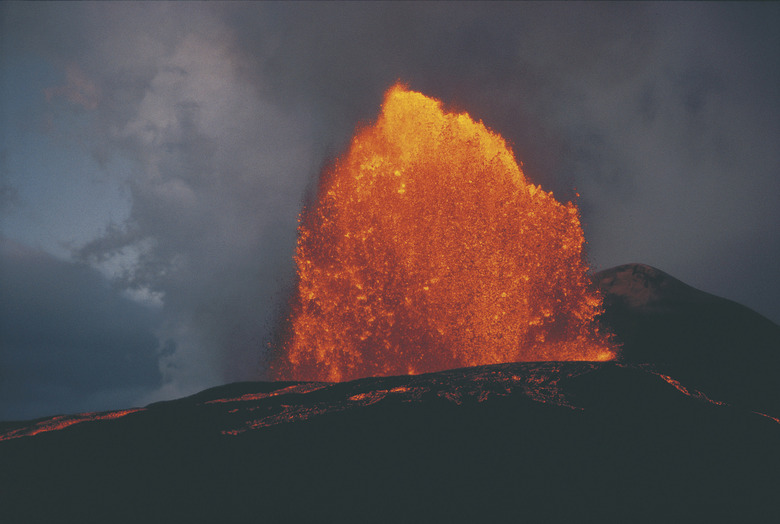Three Examples Of Environmental Disturbances In Biomes
Forces that substantially modify the structure and resources of ecosystems during a discrete event are considered ecological disturbances. They're often dramatic, as when a volcano spews lava through mountainside forests or a tornado blitzes across a prairie. In other cases they're subtler: the quiet creep of a tree-killing fungus, for example. As destructive as they can seem, disturbances are normal environmental factors in biomes, which are large-scale natural communities — tropical savannas, Arctic tundra and the like — defined by distinct geologic and climatic influences.
Ecological Disturbance Basics
Ecological Disturbance Basics
Disturbances are fundamental in biomes and ecosystems mostly because they influence succession, the temporal change in vegetation communities at a given spot. An ecosystem's "disturbance regime" is its pattern of disturbance over time, with important variables including the frequency and return interval of disturbance as well as the intensity and severity. Those last two aren't synonymous, although they're generally related: "Intensity" refers to a disturbance's energy — wind speed of a storm, heat release of a fire — while "severity" describes the magnitude of its effects on the ecosystem.
Wildfire
Wildfire
Wildfire is a major disturbance factor in many biomes, particularly forests, savannas, shrublands and grasslands. Lightning is a common cause, but so is human action: For millennia, people have ignited the countryside to improve habitat for game or other wild foods and pasture for grazing animals as well as to clear land, and anthropogenic influence appears to be significant in maintaining such ecosystems as oak savannas in the Midwest and Pacific Slope valleys of America. Ecosystems that burn frequently — such as ponderosa-pine woodlands in the Intermountain West — often experience low-severity "ground fires" because there's not much time between burns to build up huge quantities of fuel. Other natural communities experience fire on a far lower frequency but much higher intensity. Due to high moisture, tropical rainforests often don't burn for centuries, but during an extended drought a big crown fire may rage through the dense vegetation.
Storm
Storm
In some ecosystems, severe storms rank alongside or above wildfire in terms of ecological influence, with catastrophic winds among their most notable characteristics. Tropical cyclones are habitual, violent forces in certain parts of the tropics, subtropics and midlatitudes. Atlantic and Caribbean hurricanes, for example, regularly leave their mark from Central American jungles to Eastern Seaboard maritime forests. Tornadoes and downbursts — violent horizontal winds ejected from big thunderstorms — are important disturbances in mixed-hardwood forests of the central and eastern United States, flattening local tracts of timber and thus ensuring a patchwork of successional stages across the region. Heavy storm rains may result in flooding — also a separate category of disturbance — which can both kill plants and animals and deposit fertile sediments. Storm surges, massive coastal inundations triggered by tropical storms, can drown or scour barrier-island ecosystems and choke coastal forests through saltwater intrusion.
Volcanic Eruption
Volcanic Eruption
If wildfire and storms are heavily climate-influenced disturbances, volcanic eruptions are linked to tectonic turmoil, and thus occur across the biome spectrum from polar ice caps to tropical forests. Whether an explosive blast from a stratovolcano, a surging mudflow or a slow-moving sheet of basaltic lava, ecosystems in the direct path of the eruption tend to be monumentally transformed. Nonetheless, primary succession — the colonization of bare ground by lichens and plants — proceeds readily. Topographic irregularities may spare certain ecosystem patches from smothering by lava. For example, "kipukas" are islands of forest or grassland isolated amid lava flows. The name comes from Hawaii, where such refuges include some of the archipelago's least-modified tropical rainforest, but also applies to analogous situations such as grassland and shrubland kipukas of Idaho's Craters of the Moon lava beds. Coastal ecosystems far from a venting volcano may still be impacted by tsunamis, huge waves sometimes triggered by submarine eruptions or pyroclastic flows discharging into the ocean.
References
- Microdocs: Disturbance
- Landscape Ecology in Theory and Practice: Pattern and Process; Monica G. Turner, et al.
- Encyclopedia Britannica: Ecological Disturbance
- Forest Ecosystems; David A. Perry, et al.
- Savanna Oak Foundation, Inc.: Geography of Oak Savannas
- Science of the Total Environment; Catastrophic Wind Damage to North American Forests and the Potential Impact of Climate Change; Chris J. Peterson
- Journal of Vegetation Science; Early Primary Succession on Mount St. Helens, Washington, USA; R. del Moral, et al.
- National Aeronautics and Space Administration: Earth Observatory — Kipuka, Craters of the Moon
- Oregon State University: Volcano World — Volcanic Tsunamis
- U.S. Geological Survey; Wind Damage and Salinity Effects of Hurricanes Katrina and Rita on Coastal Baldcypress Forests of Louisiana; Thomas W. Doyle, et al.
Cite This Article
MLA
Shaw, Ethan. "Three Examples Of Environmental Disturbances In Biomes" sciencing.com, https://www.sciencing.com/three-examples-environmental-disturbances-biomes-11864/. 24 April 2017.
APA
Shaw, Ethan. (2017, April 24). Three Examples Of Environmental Disturbances In Biomes. sciencing.com. Retrieved from https://www.sciencing.com/three-examples-environmental-disturbances-biomes-11864/
Chicago
Shaw, Ethan. Three Examples Of Environmental Disturbances In Biomes last modified August 30, 2022. https://www.sciencing.com/three-examples-environmental-disturbances-biomes-11864/




